896103
-
STÁLE SA OPAKUJÚCE DEJE
PRESENT SIMPLE používame vtedy, ak hovoríme o dejoch (často zvykoch), ktoré sa pravidelne opakujú.
- I get up at 8 o’clock every morning
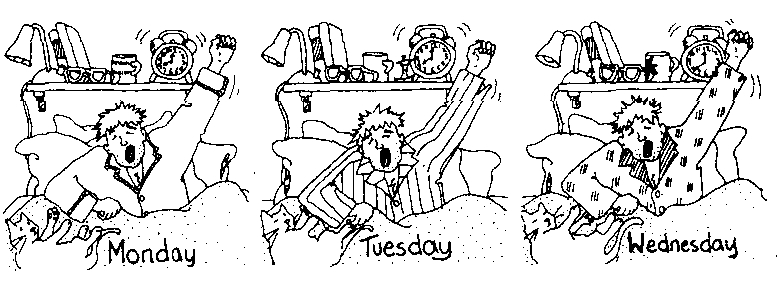
- My mum watches TV very often.
S HOW OFTEN vytvárame typickú otázku v prítomnom jednoduchom čase, pomocou ktorej sa bežne pýtame na to, ako často sa deje opakujú:
- How often do you go to school by bus?
Ako často sa dej opakuje nám pomáhajú lepšie vyjadriť aj nasledujúce “slová a slovné spojenia”. Predovšetkým ide o frekvenčné príslovky:
- ALWAYS – vždy
- USUALLY – zvyčajne, obyčajne
- NORMALLY - normálne, obvykle
- REGULARLY - pravidelne
- OFTEN – často
- SOMETIMES - niekedy, občas, sem a tam
- OCCASIONALLY – príležitostne, z času na čas
- RARELY – (len) zriedka
- SELDOM – zriedka, málokedy
- NEVER – nikdy
- FREQUENTLY – často
|
- ONCE / TWICE A DAY / WEEK / MONTH / YEAR
- THREE / FOUR / MANY TIMES A DAY / WEEK / MONTH / YEAR
- EVERY + MORNING / DAY / WEEK / YEAR / EVENING
- ON + FRIDAYS / SUNDAYS …
- AT WEEKENDS
- FROM TIME TO TIME – sem tam, z času na čas
- AT TIMES - sem tam
|
VŠEOBECNÉ FAKTY A PRAVDY
PRESENT SIMPLE používame rovnako vtedy, ak hovoríme o všeobecných faktoch a pravdách. Často sú to deje opisujúce prírodné, či fyzikálne javy, poznatky z rôznych vied alebo všeobecné tvrdenia o ľudských schopnostiach apod.

- Water boils at 100 degrees Celsium. (= Voda vrie pri 100 stupňoch.)
- The Sun sets in the west. (= Slnko zapadá na západe.)
- Cats like milk.
- His farther is Slovak.
STAVY
PRESENT SIMPLE používame zvyčajne so slovesami opisujúcimi stavy (pocity, postoje, vlastnosi, vzťahy). Medzi takéto slovesá patria napr.:
- adore / seem / understand / believe / exist / love / want / belong to / know / need …
- He loves her.
- This pen belongs to my mother.
- This house costs a lot of money.
POZOR! Niektoré stavové slovesá je možné použiť aj v priebehovom tvare a to hlavne vtedy, ak jeden z ich významov vyjadruje činnosť.
Pozn. Viac sa dočítate v článku Stavové a dynamické slovesá (stative and dynamic verbs)
SĽUBUJEM, SÚHLASÍM…
PRESENT SIMPLE často používame so slovesami ako PROMISE, SUGGEST, AGREE, SWEAR …
- “You promise?” – “All right, I promise.” (! NIE
I promising)
- I suggest we go. (! NIE
I suggesting)
BUDÚCNOSŤ
PRESENT SIMPLE používame na vyjadrenie budúcnosti hlavne vtedy, ak hovoríme o budúcich dejoch, ktoré sa riadia nejakým rozvrhom / programom / cestovným poriadkom.
- My bus leaves at 13.30. (= Môj autobus odchádza o 13.30.) – dej nevieme ovplyvniť, riadi sa podľa cestovného poriadku
- What time does the film finish this evening? (= Kedy film končí dnes večer?) – dej sa riadi podľa presne určeného programu televízie
| PRÍTOMNÝ ČAS PRIEBEHOVÝ (present continuous) |
DEJ PREBIEHAJÚCI V MOMENTE ROZHOVORU
PRESENT CONTINUOUS používame pre (prítomné) deje, ktoré prebiehajú práve teraz, teda v momente rozhovoru.
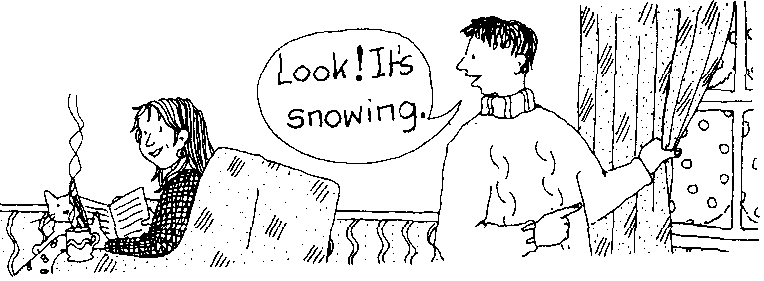
- Why are you looking at me?
- They are working very hard today.
- It is raining now.
- What are you doing?
Prítomný priebehový čas používame najčastejšie s týmito príslovkami:
-
- NOW
- RIGHT NOW
- TODAY
- THIS WEEK
- THIS YEAR
- AT THE MOMENT
- AT PRESENT
DEJ, KTORÝ NESKONČIL
PRESEN CONTINUOUS používame rovnako aj pre deje, ktoré avšak nemusia niekedy prebiehať presne v moment rozhovoru. Tieto deje začali, no ešte sa neskončili a pokračovať budú v budúcnosti. Často sa s týmto použitím stretávame vtedy, ak sme v období istého deja, hlavne dočasného, no my ho nemusíme výlučne vykonávať v momente rozhovoru, no i napriek tomu do vety často umiestňujeme príslovkové určenie at the moment.

Tieto vety často prekladáme ako “mať rozrobené / mať rozpísané / mať rozmaľované atd.“, no nie stále.
- I am reading an interesting book. It’s about a family … (= Mám rozčítanú zaujímavú knihu. Je o rodine…)
- Are you teaching at the university now? (= Učíš teraz na univerzite?) – táto otázka však môže padnúť aj pri telefonickom rozhovore dvoch známych. Daný človek, na ktorého je otázka cielená, ale nemusí v danom momente byť vôbec na pôde univerzity.)
DOČASNÉ DEJE
PRESENT CONTINUOUS je typický pre deje, ktoré sa odohrávajú dočasne (tj. prechodné deje). Tieto deje sú odlišné od tých, ktoré dotyčný pravidelne vykonáva.
- We are staying in a five-star hotel.
Napr. miesto s trvalým pobytom máme v Košiciach, no prechodne, keďže sme na služobnej ceste v Paríži bývame v hoteli. Preto by sme túto vetu povedali v prítomnom priebehovom čase, keďže dej považujeme iba za dočasný.
- We usually go to school by bus, but this month we are going on foot (= we are walking).
Zvyčajne chodíme do školy autobusom, ale tento mesiac pešky. (ZVYK – chodiť autobusom, DOČASNÁ SITUÁCIA TRVAJÚCA MESIAC – chodiť pešky)
ZMENY
PRESENT CONTINUOUS používame vtedy, ak hovoríme o prebiehajúcich zmenách. Tieto vety sú často tvorené so slovesami GET, CHANGE, START, IMPROVE, BEGIN, GROW, FALL, RISE,INCREASE.
- My English is getting better. (! NIE
gets)
- Your soup is getting colder. (! NIE
gets)
- The population of this town is increasing very fast. (! NIE
increases)
ALWAYS
PRESENT CONTINUOUS používame často s prítomným priebehovým časom, ak chceme vyjadriť príliš častý dej, s ktorým hovoriaci nie je spokojný.
- He is always losing my things.
- She is always learning English.
Porovnajte:
- PRESENT SIMPLE + ALWAYS = neutrálne vyjadrenie frekvencie deja = ako často sa dej deje? = vždy
- PRESENT CONTINUOUS + ALWAYS = citovo zafarbené (negatívne) vyjadrenie ohľadom deja = dej sa deje vkuse / neustále = hovoriaci je s dejom značne nespokojný
- He always watches TV. (= He watches TV every day.)
- He is always watching TV. (= He watches TV very often / too often.)
Namiesto ALWAYS sa v tomto význame s prítomným priebehovým časom často používajú aj tieto príslovky – FOREVER, CONTINUALLY, CONSTANTLY.
I LIKE TO TALK TO MY FRIENDS WHEN I AM HAVING LUNCH
PRESENT CONTINUOUS používame, ak hovoríme o činnostiach, ktoré robíme uprostred niečoho.
Porovnajte:
- At six we are usually having a shower. (= O šiestej sme uprostred sprchy.)
- At six we usualy have a shower. (= Šiesta hodina je typickým časom, kedy máme sprchu.)
Tento princíp môžeme použiť i pre vetách v súvetí:
- I like to talk to my friends when I am having lunch.
BUDÚCNOSŤ
PRESENT CONTINUOUS používame s budúcim významom pre budúcnosť, ktorú máme dohodnutú (naplánovanú). Dej je dopredu naplánovaný, pričom v týchto vetách často máme aj príslovkové určenie času.
- I am not working tomorrow.
- She is coming to stay with me next month.
 Článok zameraný na anglické “stavové a dynamické slovesá” (state verb / stative verbs /non-progressive verbs and action verbs / dynamic verbs). Viete prečo je veta “It is belonging to me” nesprávna? Prečítajte si tento článok.
Článok zameraný na anglické “stavové a dynamické slovesá” (state verb / stative verbs /non-progressive verbs and action verbs / dynamic verbs). Viete prečo je veta “It is belonging to me” nesprávna? Prečítajte si tento článok.

V angličtine existujú slovesá, ktoré bežne nepoužívame v priebehovom čase. Opisujú stavy a nie dynamické činnosti. Preto ich nazývame “STAVOVÉ SLOVESÁ” (state verb / stative verbs /non-progressive verbs). Napr. LIKE / BELONG / BE atd.
- I like apples. (! NIE
I am liking apples.)
- She is 30. (! NIE
She is being 30.)
- It belongs to me. (! NIE
It is belonging to me.)

Naopak, slovesá, ktoré môžeme použiť v priebehovom čase sa nazývajú “DYNAMICKÉ SLOVESÁ” (action verbs / dynamic verbs). Dynamické slovesá sú slovesá, ktoré opisujú, čo robíme alebo čo sa deje s vecami okolo nás. Napr. PLAY / GO / COME / WAIT atd.
- I am reading my new book.
- I am working in the garden.
Toto je zoznam najbežnejších stavových slovies rozdelených podľa skupín:
|
PREMÝŠĽANIE / UVAŽOVANIE / NÁZORY
|
- believe – veriť
- know - vedieť, poznať
- mean - mieniť, myslieť
- think - myslieť si, domnievať sa
- understand - rozumieť, chápať
- imagine – domnievať sa, myslieť si
- agree – zastávať rovnaký názor, súhlasiť
- see – chápať, rozumieť
|
| POCITY / EMÓCIE |
- adore – zbožňovať
- appreciate - vedieť oceniť
- hate – nenávidieť, neznášať
- like - mať rád
- love - milovať, mať rád
- need - potrebovať
- prefer - preferovať
- want – chcieť
- detest - neznášať, mať silný odpor k
- dislike - nemať v láske
- loathe - nenávidieť / neznášať, mať odpor k
- forgive - odpustiť
|
|
EXISTENCIA / BYTIE
|
- be – byť
- exist – byť, existovať
|
|
ZMYSLY
|
- feel – byť na dotyk aký, tušiť
- hear - počuť
- see – vidieť, zbadať
- smell - vydávať vôňu
- taste – mať (prí)chuť čoho
|
|
VZHĽAD
|
- appear – zdať sa, javiť sa
- resemble - podobať sa
- seem – zdať sa
- look (= appear)
|
|
VLASTNÍCTVO
|
- belong – patriť
- have - mať (vlastniť)
- own – vlastniť (mať)
- posses – vlastniť
|
|
OSTATNÉ SLOVESÁ
|
- contain - obsahovať
- consist – skladať sa
- depend - závisieť
- require – vyžadovať
- wish – chcieť
|
Nikdy nie v priebehovom čase!
Niektoré slovesá budú vždy patriť iba k stavovým slovesám. Tieto slovesá sú napr.
- belong to
- consist of
- contain
- depend
- deserve
- desire
- know
- matter
- own
- possess
- prefer
- seem
- This house belongs to my family.
- I know a few words of English.
Stavové slovesá v priebehovom čase
Niektoré slovesá, ktoré patria medzi stavové môžu byť použité i v priebehovom čase, pretože majú viacero významov. Niektoré z nich sú dynamické, iné stavové. Princíp nasledujúcej tabuľky si ukážeme na príklade so slovesom SMELL.
SMELL má dva základné významy:
- byť cítiť (vydávať vôňu)
- ovoňať
Význam A. je stavový, zatiaľ čo význam B. je dynamický.
Preložme si teda tieto štyri vety:
- Voniam kvety práve teraz. = I am smelling the flowers now.
- Voniam kvety každý deň. = I smell the flowers every day.
- Naša polievka vždy vonia dobre. = Our soup always smells good.
- Otvorím okno pretože naša spálňa smrdí príšerne. = I will open the window because our bedroom smells terrible.
SMELL vo význame OVOŇAŤ sa správa ako bežné sloveso GO, COME, PLAY – je teda dynamické. Ak mu to “časy dovolia”, môžeme ho v tomto význame použiť v priebehovom čase alebo v jednoduchom čase. Ak sme vo vete mali NOW, použili sme čas priebehový, ak sme vo vete mali naopak príslovkové určenie typické pre čas jednoduchý ako napr. EVERY DAY, použili sme sloveso SMELL v tomto význame v čase jednoduchom.
SMELL vo význame BYŤ CÍTIŤ zaradzujeme k stavovým slovesám. Prvá veta nám vyjadruje stály dej, preto je logické, že v nej nepoužijeme prítomný čas priebehový, ale jednoduchý. V druhej vete je to podstatne iné. Logicky do tejto vety patrí prítomný čas priebehový. Rozhodneme sa v momente rozhovoru otvoriť okno, pretože aktuálny prebiehajúci dej nás k tomu dovedie. Ako však vidíme, sloveso SMELL nedáme do priebehového času, pretože v tomto význame je to stavové sloveso.
-
-
- I will open the window because our bedroom
is smelling terrible.
Takto sa správajú aj slovesá v nasledujúcej tabuľke. Jeden ich význam je dynamický (vtedy sa môžu nachádzať podľa situácie ako v priebehovom čase, tak i jednoduchom čase), druhý ich význam je stavový (vtedy sa môžu nachádzať iba v čase jednoduchom):
| She is having dinner at the moment. (HAVE = jesť) |
She has a new bicycle. (HAVE = vlastniť) |
| I am thinking of selling my house. (THINK = uvažovať) |
I think we should go to bed now. (THINK = myslieť si, domnievať) |
| He is appearing on television today. (APPEAR = vystúpiť / vystupovať) |
She appears to be hungry. (APPEAR = zdať sa) |
| They are smelling the flowers. (SMELL = ovoňať) |
The soup smells good. (SMELL = byť cítiť, vydávať vôňu) |
| I am seeing her tomorrow morning. (SEE = navštíviť) |
I see what you mean. / Now I see. (SEE = rozumieť,chápať) |
| She is being very patient today. (BE = správať sa) |
She is usually very patient. (BE = byť) |
| We are tasting wines. (TASTE = ochutnať / degustovať) |
The soup tastes horrible. (TASTE = mať príchuť / chutiť) |
| I am weighing this book. (WEIGH = zvážiť niečo) |
This book weighs 2 kilos. (WEIGH = vážiť koľko) |
| We are really admiring the view. (ADMIRE = kochať sa čím) |
I think they admire my courage. (ADMIRE = obdivovať) |
| I am feeling fine. (FEEL = cítiť sa) |
I feel I should go home. (FEEL = tušiť, mať názor) |
| She is feeling her skirt to see if it is dry. (FEEL = ohmatať) |
Her skirt feels soft. (FEEL = byť na dotyk aký) |
| We are fitting the new carpet tomorrow. (FIT = pripevniť) |
This size fits me. (FIT = pasovať, sedieť) |
| I am measuring this table. (MEASURE = zmerať, premerať) |
This table measures 25 cm across. (MEASURE = merať /mať dĺžku/ |
Stavové slovesá používame niekedy v priebehovom čase preto, lebo chceme veľmi zdôrazniť aktuálnu, krátkodobú situáciu. Toto je typické pre slovesá LOVE / LIKE / COST / HOPE…
- I like films. (stály / všeobecný postoj)
- I‘m liking every minute of this film. (konštatovanie počas filmu)
So slovesami, ktoré opisujú ako sa fyzicky teraz cítime, môžeme použiť jednoduchý čas, ale aj priebehový a to bez zmeny vo význame.
- I feel sick. / I am feeling sick.
- My legs ache. / My legs are aching.
- My hand hurts. / My hand is hurting.
Tvar AM / IS / ARE BEING + PRÍDAVNÉ MENO nám opisuje ako sa niekto aktuálne správa. Ak opisujeme všeobecný povahový rys, použijeme iba AM / IS / ARE + PRÍDAVNÉ MENO. Porovnajte:
- He is very patient. – On je veľmi rozvážny (= všeobecnosť, opisujem povahový rys)
- He is being very patient. – On sa správa veľmi rozvážne. (= aktuálny stav, opisujeme ako sa niekto správa)
POZOR! Ak AM / IS / ARE BEING + PRÍDAVNÉ MENO vo vete nemôžeme preložiť ako SPRÁVAŤ SA, priebeh nepoužijeme.
- I am not tired at all. (! NIE
I am not being tired at all.)
Slovesá zmyslového vnímania ako SEE / SMELL / HEAR / TASTE, ak sa vo vete nenachádzajú vo svojom statickom význame bežne nepoužívame v priebehovom čase. Ak chceme zdôrazniť priebehovosť, používame s týmito slovesami modálne sloveso CAN (pre prítomnosť), COULD (pre minulosť).
- I could hear their footsteps.
- I can hear their footsteps.
Priebehový tvar so stavovými slovesami občas používame preto, aby sme pri stavovom na stavové sloveso dali dôraz na momentálny stav.
- I’m loving it! = I’m really enjoying it.
Niektorí učitelia vám budú tvrdiť, že tieto tvary nie sú správne. Opak je však pravdou. Na druhej strane toto použitie nie je tak bežné, preto sa vás na to v teste určite nikto nespýta. Buďte teda s týmto použitím stavových slovies opatrní a ak to ide, vyhnite sa mu.
Prečo je možné slovesá LOOK AT / LOOK FORRWARD TO / LOOK FOR … / WATCH / LISTEN použiť v priebehovom tvare? Vyjadrujú totiž deje, ktoré robíme úmyselne. Patria k dynamickým slovesám.
- I am looking at you.
- I am watching TV.
- I am listening to the news on the radio.
Revise Mood Fodd, retell the content of the article giving more details about "kitchen therapy",the research and experiment.
learn by heart YOUR DIET (in your exercise-book),
Vocabulary bank 152/learn fish and fisfood, fruit and vegetables, processes of preparation food, phrasal verbs.
My Eating Habits - 250 words at least
Monday next week is the deadline, i.e. October 15th - napísať povinne rukou a na A4, dvojhárok alebo decent sheet of paper
the essay should contain these points
1. evaluation of your eating habits and steps you should take to change your eating habits in order to improve them.
2. what you usually have for breakfast/snack/lunch/dinner/supper during the school week (drinks included) and at weekend and where
3. your favourite food/fruit/vegetable/drink and why
5. what you eat on special occasions when your family/friends get together - Christmas, Easter, your birthday.
4. Can you cook? If so, describe a meal you have recently cooked. If not, would you like to learn how to cook? Why? Why not?
5. what is your opinion on healthy and junk food
6. what are the pros and cons of being a vegetarian/vegan
Pomôžte si nasledovnými, najmä 05_CARD_food.pdf
ood PowerPoint presentation: 05_FOOD.ppt
food topic: 17.food.docx
worksheet we used in the lesson: 05_CARD_food.pdf
Vocabulary Bank 152
ENGLISH FILE page 5 make notes and talk about MOOD FOOD
+ FOOD in Yes!book + recipe
COLOUR MIXING

https://www.youtube.com/watch?v=9hirYMZ7PQc
video we watched today dealing with rgb vs cmyk https://www.youtube.com/watch?v=9hirYMZ7PQc
|
Additive Colour Mixing RGB
|
Subtractive Colour Mixing CMYK
|
|
Red + Green = Yellow
|
Cyan + Magenta = Blue
|
|
Blue + Green = Cyan
|
Magenta + Yellow = Red
|
|
Red + Blue = Magenta
|
Cyan + Yellow = Green
|
|
Red + Green + Blue = White
|
Cyan + Magenta + Yellow = black (Key)
|
Used in: monitors, projectors, scanners Used in: printers
COLOUR THEORY:
Whatever is used in the way of technical aids or colour classification systems must be aligned with
- the colour perception of the eye of the human observer
- and in the range of spectrum of electromagnetic waves visible to the human eye.
Both additive and substractive colour mixing processes occur in modern reproduction theory.
WATCH!!!!!!!
video explaining primary, secondary and tertiary and complimentary colours https://www.youtube.com/watch?v=L1CK9bE3H_s&t=2s
video about psychology of colours https://www.youtube.com/watch?v=s6ImJkv7F_Q
or https://www.youtube.com/watch?v=8n9BzzWy4zY
In additive colour mixing light is emitted by the source of its own.
SB 45, 47, 48, WB 31 Retell the stories in detail focusing on phrases, dependent prepositions, phrasal verbs and, of course, the contents.
WB 31 The fisherman and the banker/ Write the contect in 250 words. Talk about the story.
Talk about healthy life style and diet according to the articles - SB 40, WB 35 and your notes Eat healthy! Stay healthy!
SB 40/ 2 READING AND LISTENING, ex a,b,
Written homework in your exercise books exercise SB 40/ ex. d - answer the questions in at least 160 words together.
WRITING SECTION 114/ a model text.
Describe Bratislava or Pezinok. Search information on the net to complete your description according the model text. Use all the useful phrases and expressions that you wrote into your exercise-books in our lesson.
Retake the test at home. Be more attentive than in the lesson.
SB 36/ ex. e Answer the questions. Write in detail, explain, comment, analyse.
How fast my life is (160-180 words)
Revision EF 3 and 4 SB 34-35
How My Life Has Changed Over the Last 2 Years (160-180 words)
1. Do you spend more or less time on these things? Say why.
- working or studying
- getting to work / school
- sitting in traffic
- talking to friends
- being online
- sleeping cooking
- shopping
- eating
- using your phone
- using your computer
2. Do you have more or less free time? Why?
3. What don´t you have tome for nowadays? Why?
What would you like to have more time for?
MY LAST WEEKEND, SB 33 /5 SPEAKING ex.c- questions will help you
Revise EASTER
SB 33/4 Reading the article: What did you really do at the weekends? Learn vocabulary and talk about why people invent details about weekend and don´t tell the truth.
21st February
SB 33/4 Reading the article: What did you really do at the weekends? + SB 32/ 4Reading ex. b
WB 27/ 2Grammar_ex. a, b
WB 24_2 Grammar _ex.a,b
http://english-theatre.cz/Oliver-Twist-education-pack.pdf
Learn about Ch. Dickens and Oliver Twist.
Write down 3 annoying habits you have, 3 annoying habits your parents have.
Revise: Paraphrasing (SB 24), Creating of new words (SB 25)
WB 24/2 Grammar ex. b + 3 Pronunciation, WB 25/ 4 Reading ex. a, b
16th January
FUTURE
https://www.englisch-hilfen.de/en/exercises/tenses/future.htm
WB 19/1 GRAMMAR, ex. a, b
Revise BE GOING TO - Grammar bank 130, WB 17
By heart (naspamäť) AIRPORT, WB 17
14th December
WB 17/ 2 Vocabulary - learn by heart like a poem.
2 lift, 3 Departures, 4 check-in, 5 gate, 6 passport control, 7 Baggage Reclaim, 8 trolley, 9 customs, 10 Arrivals
12th December
The Way I Live
(Opinion essay)
Introduction - Recently I have been thinking a lot about my life. I have been affected with the article we read in the English lesson.
Body - 1 Deal with these questions: Do you appreciate the warmth of your cosy room? What about the Africans, Eskimos?
2 Are you grateful for the stability of your life and the peace you are living in? Is it easy to flee from your
own country because of war?
3 Are you happy with using modern technology? Imagine yourself being an Amish and compare.
4 Can you imagine your life without a central heating, a flush-toilet, electric light, a microwave oven,
a washing machine or even a hair-dryer? If yes/no, why/why not?
Conclusion - There are so many possibilities of our existence. Remember how to cope with things and troubles.
Stop worrying, enjoy every day as a gift, and keep your mind open to notice the beauty and possibilities
regardless of your race, social status, wealth or ability.
8th December
REVISION: EF 1 EF 2 + Dictionary - the link above
6th December
Is This the Only Way to Live? Learn and talk about the article. Use your notes.
5th December
REVISION EF 1-2 + ONLINE DICTIONARY EF 1-2
Written homework - Something interesting happened to me
10 -15 sententes
Be careful about chroonology:
Grammar: Use the Past tenses, time sequencers.
29 November
GRAMMAR Bank 128-129/ 2C ex.a, b
24 November
Writing Section - 112 My Favourite Photo (Blog) ex. c (The right order 3,5,4,1,2)
Picture description
15th November
Vocabulary bank 153/make notes and learn prepositions AT IN ON , do the exercise 2 Verbs + prepositions if any mistakes, we´ll check and correct.
SB 14 / A moment in history - retell the story using the past tense
Remember to do the previous homework SB 12/Laura notes and talk about their holiday.
8th October
Learn about the two holidays Guy Fawkes/Bonfire night and Thanksgiving
Revise tenses: PRESENT SIMPLE and CONTINUOUS and PAST SIMPLE and CONTINUOUS
25th October
WB 11-12/2 Grammar/ ex. b,c,d
WB Check and do page 6/ 1 Grammar ex. c, page 9/2 Grammar ex. a
18th October
Grammar bank 129/2a, ex. a, b
17th October
PLS LEARN words FILE 1 in EF_3e_Pre-int_Slovak_WL.pdf
for a short vocabulary and grammar test (the present simple and continuous + prepositions of place)
13th October
Revise Hockney´s painting - description and facts about the painting and Charlotte, Alex and Oliver (see details under 12th October)
SB 9/ 5 Vocabulary ex. a
WB 8/Vocabulary ex. a, b
12th October
PLS LEARN words FILE 1 in EF_3e_Pre-int_Slovak_WL.pdf
1 SB 8 / Listening ex. b (Script on page 118 in Section LISTENING can help you.) + Vocabulary BANK CLOTHES and speaking about Hockney´s painting on page 9 in SB
2 Revise Charlotte´s choice and Alexander and Oliver (Descriptions and characteristics)
5th October
Learn vocabulary Charlotte´s Choice and answer in detail the two questions:
What does Charlotte look like? What is she like? ( Any problem? Look at magnifying glass-lupa on page 6.)
3rd-4th October
SB 6/2 Reading, read with understanding. Write down new words and phrases you don´t understand, pls.
Revise Numbers and page 164/IRREGULAR VERBS (test)
29th September
SB (Student´s Book) page 4 Write into your exercise-books and at school you will give us your personal information and will talk about your FREE TIME.
WB (Workbook) 4-5 exercises, Revise Numbers and page 164/IRREGULAR VERBS
28th September
Punctuation
Revise History of typography + Punctuation
History of Typography for graphic designers and graphic artists
http://planetoftheweb.com/components/promos.php?id=174
Picture writing
The first type of messages that we find in the history records were a series of pictures that told a story known as pictographs.

From pictographs developed more sophisticated ways of communicating through ideographs. Ideographs substituted symbols and abstractions for pictures of events. A symbol of a star represented the heavens or a peace pipe represented peace. Native Americans and Egyptians are examples of some folks who used ideographs. Chinese alphabets are still based on ideographs.
From ideographs developed a system pioneered by the Egyptians known as hieroglyphics. The Egyptians still used drawings to represent objects or ideas, but were the first to use objects to re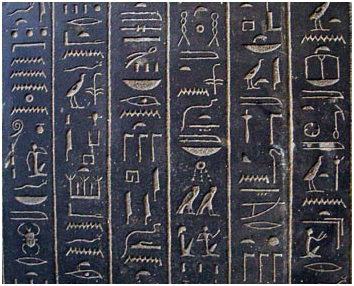 present sounds.
present sounds.
Letter Development
At around 1200 BC, the Phoenicians gained their independence from the Egyptians and developed their own alphabet that was the first to be composed exclusively of letters.
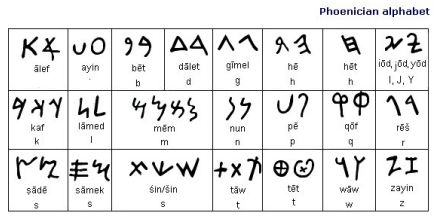
The Greeks adopted the Phoenician language and began to develop the true beginnings of our modern alphabet. The Greeks refined the Phoenician language by adding the first vowels (5 of them). Their language did not have punctuation, lowercase letters or spaces between words.
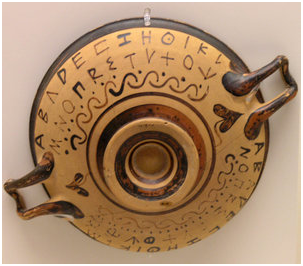
The Roman Revolution
The next great civilization, the Romans further developed the alphabet by using 23 letters from the Etruscans who based their language on the Greek. They took the letters ABEZHIKMNOTXY intact, they remodeled the CDGLPRSV and revived two Phoenicians letters discarded by the Greeks, the F and Q. The Z comes at the end of our alphabet because for a while the Romans discarded it, but then brought it back when they thought it was indispensable. The Romans contributed short finishing strokes at the end of letters known as serifs. Roman letters feature the first examples of thick and thin strokes.
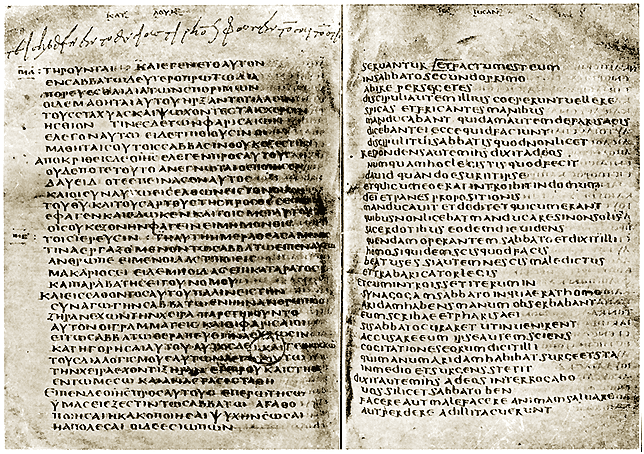

Lowercase letters developed because all type was hand copied by scribes who developed less ornate handwriting styles and started using quicker and smaller versions of the letters. The first system of lowercase letterforms was known as the semi-uncial.
The U and W were slowly added and based on the letter V by the year 1000 and the J, which was based on the I was added by 1500. Spacing between words was not generally adopted until the eleventh century. Punctuation marks developed in the 16th century when printing became prevalent.

Johannes Gutenberg (1398-1468)
Pls, learn the basics about Johannes Gutenberg plus learn the vocabulary you can find below the text. In case you wish to download the stuff, just click on the following link J._Gutenberg2017._upravene.docx

Johannes Gutenberg (1398-1468)
Johannes Guttenberg invented the printing press - the most important invention in modern times.
Without books and computers we wouldn't be able to learn, to pass on information, or to share scientific discoveries. Prior to Gutenberg invented the printing press, making a book was a hard process. It wasn't that hard to write a letter to one person by hand, but to create thousands of books for many people to read was nearly impossible. Without the printing press we wouldn't have had the Scientific Revolution or the Rennaisance. Our world would be very different.
He was born in Mainz, Germany around the year 1398. He was the son of a goldsmith. We do not know much about his childhood. He moved a few times around Germany, but that's all we know for sure.
Inventions
Gutenberg took some existing technologies and some of his own inventions to invent the printing press in the year 1450. One key idea he came up with was moveable type. Rather than use wooden blocks to press ink onto paper, Gutenberg used moveable metal pieces to quickly create pages. He made innovations all the way through the printing process enabling pages to be printed faster. His presses could print thousands of pages per day vs. 40-50 with the old method. This was a dramatic improvement and allowed books to be acquired by the middle class and spread knowledge and education like never before. The invention of the printing press spread rapidly throughout Europe and soon thousands of books were being printed using printing presses.
Among his many contributions to printing are:
- The invention of a process for mass-producing movable type;
- The use of oil-based ink for printing books (farba na olejovom základe)
- Adjustable moulds (nastaviteľné formy)
- Mechanical movable type (mechanická pohyblivá sadzba)
- The use of a wooden printing press similar to the agricultural screw presses (skrutkový lis) of the period
Combination of these elements into a practical system allowed the mass production of printed books.
Gutenberg's method for making type is traditionally considered to have included a type metal alloy (sadzba zhotovená zo zliatiny kovov) and a hand mould (ručná forma) for casting type (odlievanie sadzby). The alloy (zliatina) was a mixture of lead (olova), tin (cínu), and antimony (antimónu) that melted (tavila sa) at a relatively low temperature for faster and more economical casting (odlievanie), cast well (dobre sa odlieval), and created a durable type (a vytvoril trvácnu sadzbu)
First printed books
It is thought that the first printed item using the press was a German poem. Other prints included Latin Grammars and indulgences for the Catholic Church. His real fame came from producing the Gutenberg Bible. It was the first time a Bible was mass-produced and available for anyone outside the church. Bibles were rare and could take up to a year for a priest to transcribe. Gutenberg printed around 200 of these in a relatively short time.

The original Bible was sold for 30 florins. This was a lot of money back then for a commoner, but much, much cheaper than a hand-written version.
There are about 21 complete copies of Gutenberg Bible existing today. One copy is worth about 30 million dollars.
Vocabulary:
Printing press – tlačiarenský stroj invention – vynález
Pass on information – postúpiť, poslať ďalej informáciu
Share scientific discoveries – zdieľať, podeliť sa o vedecké objavy
Prior to – pred, skôr ako invent – vynájsť
Nearly – takmer Scientific Revolution – vedecko-technická revolúcia
Goldsmith – zlatník move – sťahovať sa
For sure – naisto, s istotou key idea –kľúčová/hlavná myšlienka (nápad)
come up with – prísť s čím, vymyslieť moveable type – pohyblivá sadzba
rather than – radšej ako, skôr ako wooden blocks – drevené bloky/kvádre
ink – farba, atrament metal pieces – kovové kusy
all the way through – úplne, v celom enable – umožniť
improvement – zlepšenie allow – dovoliť, povoliť
acquire – získať, dosiahnuť spread – šíriť
knowledge – vedomosti, znalosti education – vzdelanie
mass-produce – masovo vyrábať oil-based ink – farba/atrament na olejovom základe
adjustable – nastaviteľný mould – forma
wooden – drevený similar to – podobný ako
agricultural – poľnohospodársky screw press – skrutkový lis
mass production – masová výroba considered – považovaný
consider – považovať include – zahŕňať
type metal alloy – sadzba zhotovené zo zliatiny kovov alloy – zliatina
hand mould – ručná forma casting type – odlievanie sadzby
type – sadzba mixture – zmes
lead – olovo tin – cín
antimony – antimón melt – taviť sa
low temperature – nízka teplota durable – odolný, trvácny
item – položka, kus German – nemecký
poem – báseň indulgences – odpustky
Catholic Church – katolícka cirkev real – skutočný
Fame – sláva available – dostupný
Rare – vzácny, zriedkavý take up to a year – trvať až rok
Priest – kňaz transcribe – prepísať
Original – pôvodný commoner – bežný človek
Copy – výtlačok worth - hoden
POZOR! V otázke / zápore pri 3. osobe jednotného čísla (= HE / SHE / IT) v prítomnom čase jednoduchom koncovku -S, -ES k slovesu nedávame (prechádza k pomocnému slovesu)!




 Článok zameraný na anglické “stavové a dynamické slovesá” (state verb / stative verbs /non-progressive verbs and action verbs / dynamic verbs). Viete prečo je veta “It is belonging to me” nesprávna? Prečítajte si tento článok.
Článok zameraný na anglické “stavové a dynamické slovesá” (state verb / stative verbs /non-progressive verbs and action verbs / dynamic verbs). Viete prečo je veta “It is belonging to me” nesprávna? Prečítajte si tento článok.





